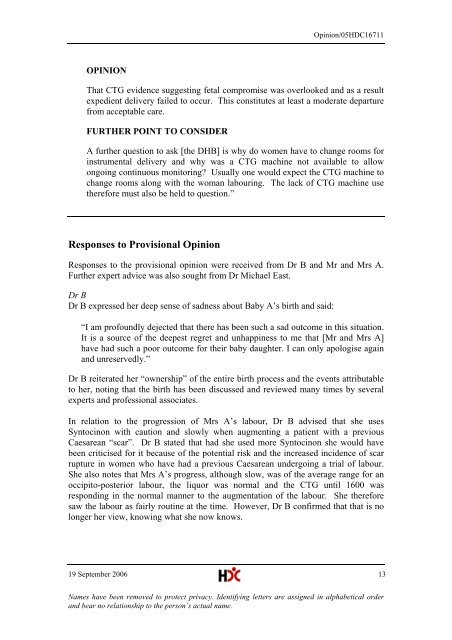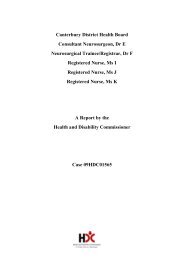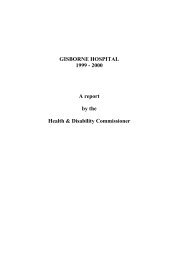Download the pdf version of this decision. - Health and Disability ...
Download the pdf version of this decision. - Health and Disability ...
Download the pdf version of this decision. - Health and Disability ...
You also want an ePaper? Increase the reach of your titles
YUMPU automatically turns print PDFs into web optimized ePapers that Google loves.
Opinion/05HDC16711<br />
OPINION<br />
That CTG evidence suggesting fetal compromise was overlooked <strong>and</strong> as a result<br />
expedient delivery failed to occur. This constitutes at least a moderate departure<br />
from acceptable care.<br />
FURTHER POINT TO CONSIDER<br />
A fur<strong>the</strong>r question to ask [<strong>the</strong> DHB] is why do women have to change rooms for<br />
instrumental delivery <strong>and</strong> why was a CTG machine not available to allow<br />
ongoing continuous monitoring? Usually one would expect <strong>the</strong> CTG machine to<br />
change rooms along with <strong>the</strong> woman labouring. The lack <strong>of</strong> CTG machine use<br />
<strong>the</strong>refore must also be held to question.”<br />
Responses to Provisional Opinion<br />
Responses to <strong>the</strong> provisional opinion were received from Dr B <strong>and</strong> Mr <strong>and</strong> Mrs A.<br />
Fur<strong>the</strong>r expert advice was also sought from Dr Michael East.<br />
Dr B<br />
Dr B expressed her deep sense <strong>of</strong> sadness about Baby A’s birth <strong>and</strong> said:<br />
“I am pr<strong>of</strong>oundly dejected that <strong>the</strong>re has been such a sad outcome in <strong>this</strong> situation.<br />
It is a source <strong>of</strong> <strong>the</strong> deepest regret <strong>and</strong> unhappiness to me that [Mr <strong>and</strong> Mrs A]<br />
have had such a poor outcome for <strong>the</strong>ir baby daughter. I can only apologise again<br />
<strong>and</strong> unreservedly.”<br />
Dr B reiterated her “ownership” <strong>of</strong> <strong>the</strong> entire birth process <strong>and</strong> <strong>the</strong> events attributable<br />
to her, noting that <strong>the</strong> birth has been discussed <strong>and</strong> reviewed many times by several<br />
experts <strong>and</strong> pr<strong>of</strong>essional associates.<br />
In relation to <strong>the</strong> progression <strong>of</strong> Mrs A’s labour, Dr B advised that she uses<br />
Syntocinon with caution <strong>and</strong> slowly when augmenting a patient with a previous<br />
Caesarean “scar”. Dr B stated that had she used more Syntocinon she would have<br />
been criticised for it because <strong>of</strong> <strong>the</strong> potential risk <strong>and</strong> <strong>the</strong> increased incidence <strong>of</strong> scar<br />
rupture in women who have had a previous Caesarean undergoing a trial <strong>of</strong> labour.<br />
She also notes that Mrs A’s progress, although slow, was <strong>of</strong> <strong>the</strong> average range for an<br />
occipito-posterior labour, <strong>the</strong> liquor was normal <strong>and</strong> <strong>the</strong> CTG until 1600 was<br />
responding in <strong>the</strong> normal manner to <strong>the</strong> augmentation <strong>of</strong> <strong>the</strong> labour. She <strong>the</strong>refore<br />
saw <strong>the</strong> labour as fairly routine at <strong>the</strong> time. However, Dr B confirmed that that is no<br />
longer her view, knowing what she now knows.<br />
19 September 2006 13<br />
Names have been removed to protect privacy. Identifying letters are assigned in alphabetical order<br />
<strong>and</strong> bear no relationship to <strong>the</strong> person’s actual name.
















